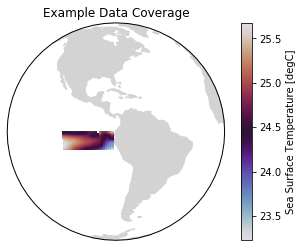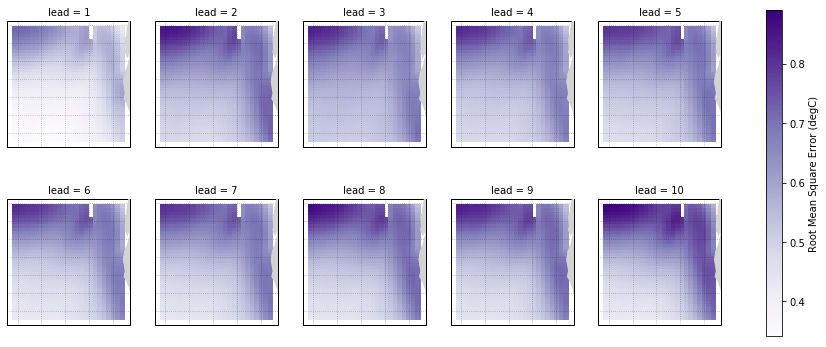Hindcast Predictions of Equatorial Pacific SSTs¶
In this example, we evaluate hindcasts (retrospective forecasts) of sea surface temperatures in the eastern equatorial Pacific from CESM-DPLE. These hindcasts are evaluated against a forced ocean–sea ice simulation that initializes the model.
See the quick start for an analysis of time series (rather than maps) from a hindcast prediction ensemble.
[1]:
import warnings
import cartopy.crs as ccrs
import cartopy.feature as cfeature
%matplotlib inline
import matplotlib.pyplot as plt
import numpy as np
import climpred
from climpred import HindcastEnsemble
[2]:
warnings.filterwarnings("ignore")
We’ll load in a small region of the eastern equatorial Pacific for this analysis example.
[3]:
climpred.tutorial.load_dataset()
'MPI-control-1D': decadal prediction ensemble area averages of SST/SSS/AMO.
'MPI-control-3D': decadal prediction ensemble lat/lon/time of SST/SSS/AMO.
'MPI-PM-DP-1D': area averages for the control run of SST/SSS.
'MPI-PM-DP-3D': lat/lon/time for the control run of SST/SSS.
'CESM-DP-SST': decadal prediction ensemble of global mean SSTs.
'CESM-DP-SSS': decadal prediction ensemble of global mean SSS.
'CESM-DP-SST-3D': decadal prediction ensemble of eastern Pacific SSTs.
'CESM-LE': uninitialized ensemble of global mean SSTs.
'MPIESM_miklip_baseline1-hind-SST-global': initialized ensemble of global mean SSTs
'MPIESM_miklip_baseline1-hist-SST-global': uninitialized ensemble of global mean SSTs
'MPIESM_miklip_baseline1-assim-SST-global': assimilation in MPI-ESM of global mean SSTs
'ERSST': observations of global mean SSTs.
'FOSI-SST': reconstruction of global mean SSTs.
'FOSI-SSS': reconstruction of global mean SSS.
'FOSI-SST-3D': reconstruction of eastern Pacific SSTs
[4]:
hind = climpred.tutorial.load_dataset('CESM-DP-SST-3D')['SST']
recon = climpred.tutorial.load_dataset('FOSI-SST-3D')['SST']
print(hind)
<xarray.DataArray 'SST' (init: 64, lead: 10, nlat: 37, nlon: 26)>
[615680 values with dtype=float32]
Coordinates:
TLAT (nlat, nlon) float64 ...
TLONG (nlat, nlon) float64 ...
* init (init) float32 1954.0 1955.0 1956.0 1957.0 ... 2015.0 2016.0 2017.0
* lead (lead) int32 1 2 3 4 5 6 7 8 9 10
TAREA (nlat, nlon) float64 ...
Dimensions without coordinates: nlat, nlon
These two example products cover a small portion of the eastern equatorial Pacific.
[5]:
ax = plt.axes(projection=ccrs.Orthographic(-80, 0))
p = ax.pcolormesh(recon.TLONG, recon.TLAT, recon.mean('time'),
transform=ccrs.PlateCarree(), cmap='twilight')
ax.add_feature(cfeature.LAND, color='#d3d3d3')
ax.set_global()
plt.colorbar(p, label='Sea Surface Temperature [degC]')
ax.set(title='Example Data Coverage')
[5]:
[Text(0.5, 1.0, 'Example Data Coverage')]

We first need to remove the same climatology that was used to drift-correct the CESM-DPLE. Then we’ll create a detrended version of our two products to assess detrended predictability.
[6]:
# Remove 1964-2014 climatology.
recon = recon - recon.sel(time=slice(1964, 2014)).mean('time')
# Remove trend to look at anomalies.
recon = climpred.stats.rm_trend(recon, dim='time')
hind = climpred.stats.rm_trend(hind, dim='init')
Although functions can be called directly in climpred, we suggest that you use our classes (HindcastEnsemble and PerfectModelEnsemble) to make analysis code cleaner.
[7]:
hindcast = HindcastEnsemble(hind)
hindcast.add_reference(recon, 'reconstruction')
print(hindcast)
<climpred.HindcastEnsemble>
Initialized Ensemble:
SST (init, lead, nlat, nlon) float32 -0.29811984 ... 0.5265896
reconstruction:
SST (time, nlat, nlon) float32 0.2235269 0.22273289 ... 1.3010706
Uninitialized:
None
Anomaly Correlation Coefficient of SSTs¶
We can now compute the ACC over all leads and all grid cells.
[8]:
predictability = hindcast.compute_metric(metric='acc')
# `compute_metric` dropped the TLAT coordinate for some reason. This will
# be fixed in a later version of `climpred`.
predictability['TLAT'] = recon['TLAT']
predictability = predictability.set_coords('TLAT')
We use the pval keyword to get associated p-values for our ACCs. We can then mask our final maps based on  .
.
[9]:
significance = hindcast.compute_metric(metric='pval')
# `compute_metric` dropped the TLAT coordinate for some reason. This will
# be fixed in a later version of `climpred`.
significance['TLAT'] = recon['TLAT']
significance = significance.set_coords('TLAT')
# Mask latitude and longitude by significance for stippling.
siglat = significance.TLAT.where(significance.SST <= 0.05)
siglon = significance.TLONG.where(significance.SST <= 0.05)
[10]:
p = predictability.SST.plot.pcolormesh(x='TLONG', y='TLAT',
transform=ccrs.PlateCarree(),
col='lead', col_wrap=5,
subplot_kws={'projection': ccrs.PlateCarree(),
'aspect': 3},
cbar_kwargs={'label': 'Anomaly Correlation Coefficient'},
vmin=-0.7, vmax=0.7,
cmap='RdYlBu_r')
for i, ax in enumerate(p.axes.flat):
ax.add_feature(cfeature.LAND, color='#d3d3d3', zorder=4)
ax.gridlines(alpha=0.3, color='k', linestyle=':')
# Add significance stippling
ax.scatter(siglon.isel(lead=i),
siglat.isel(lead=i),
color='k',
marker='.',
s=1.5,
transform=ccrs.PlateCarree())

Root Mean Square Error of SSTs¶
We can also check error in our forecasts, just by changing the metric keyword.
[11]:
rmse = hindcast.compute_metric(metric='rmse')
rmse['TLAT'] = recon['TLAT']
rmse = rmse.set_coords('TLAT')
[12]:
p = rmse.SST.plot.pcolormesh(x='TLONG', y='TLAT',
transform=ccrs.PlateCarree(),
col='lead', col_wrap=5,
subplot_kws={'projection': ccrs.PlateCarree(),
'aspect': 3},
cbar_kwargs={'label': 'Root Mean Square Error (degC)'},
cmap='Purples')
for ax in p.axes.flat:
ax.add_feature(cfeature.LAND, color='#d3d3d3', zorder=4)
ax.gridlines(alpha=0.3, color='k', linestyle=':')
